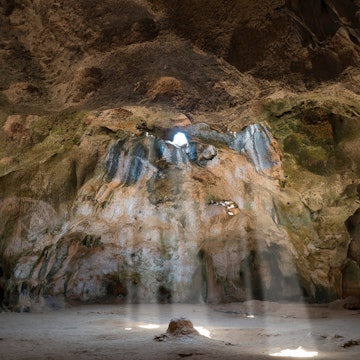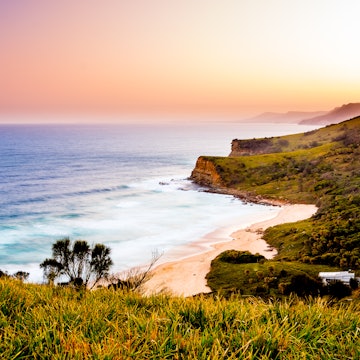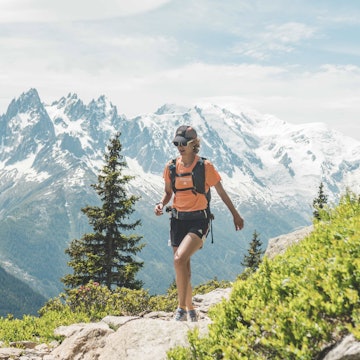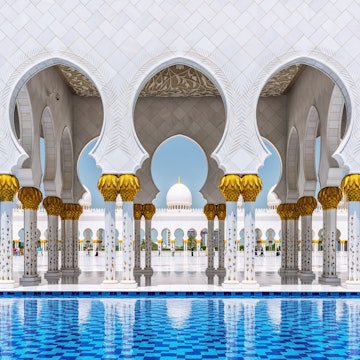
Escaping Thimphu: where to go to find Bhutan’s hidden treasures
Nov 5, 2018 • 9 min read

You may see more yaks than people on a mountain trek in Bhutan. jankovoy / Getty Images
Bhutan may be a tiny dot on the map, but its topography is epic, even daunting, in scale. Measured in terms of altitude change rather than miles, this is a big country to explore. Beyond the gateways of Thimphu and Paro there are countless valleys in which to lose one's self and discover some of this Himalayan country’s less obvious gems. Places where global influence is less obvious, where nature is at its most untamed, and where traditional Buddhist culture still thrives.
The dzongs (fortress monasteries) close to Paro and Thimphu are obvious first stops on that once-in-lifetime Bhutan trip, but for travellers looking to enrich the Bhutan experience, here’s a quick guide to some of the top experiences in the further reaches of the kingdom – places where global influence is less, where nature is at its most untamed, and where traditional Buddhist culture still thrives.
Hunting the Himalayan blue poppy in Haa
Although it is just a half-day drive to the west of Paro, fewer than 10% of visitors to Bhutan make it into the gorgeous Haa Valley. There are just two roads into and out of this little-visited province, and the most dramatic makes the narrow, twisting crossing of the 3810m Cheli La, home to Bhutan’s national flower, the Himalayan blue poppy.
In season, botanists and flower fans from across the globe come to these exposed alpine meadows to witness this rare mountain poppy in bloom. As well as blue poppies, there are yellow, white and red poppies, some of which are found only in Haa. The only time you can catch these celebrated plants in full glory is from mid-June to late July, when the thunder in the Land of the Thunder Dragon comes mainly from monsoon thunderstorms.

Outdoor pursuits around Punakha
While Punakha is a top tourist destination thanks to its beautifully-sited dzong at the confluence of two sacred rivers, most move quickly on to the next stop, missing the scenic mountain bike trails with expansive views that slice through the nearby hills. Punakha is also the starting point for rafting on the Pho Chhu river, beginning with a bracing hike along the river bank to the put-in at Samdingkha. The river features a couple of class III rapids and ends near the Punakha Dzong, at a rapid known appropriately as the Wrathful Buddha. A more relaxing float along the less tempestuous Mo Chhu, which meets the Pho Chhu at Punakha, is a good introduction for novices.
For a more gentle Punakha experience, a road up the west side of the Mo Chhu leads north towards Jigme Dorji National Park – a worthy excursion that offers up excellent birdwatching opportunities near Tashitang village, plus the chance to visit 17th-century Trashi Thongmoen Dzong and soak in Gasa’s celebrated medicinal hot springs.

Biking, hiking & birding in the Phobjikha Valley
It looks almost like a vast ice-cream scoop has been used to create the glacial valley of Phobjikha, east of Wangdue Phodrang. The main village of Gangte boasts an impressive goemba (monastery) overlooking the bowl-shaped valley, and from this base you can hit the trails, either on foot or on a mountain bike, and spot rare and endangered wildlife. The marshy valley floor is the most celebrated winter roosting ground for endangered Black-necked Cranes. These whimsical looking birds migrate from Tibet to Bhutan in late autumn, typically in the last week of October, over-wintering in the valley in their hundreds.

Natural encounters in the southern borderlands
Abutting the Indian border, Bhutan’s steamy southern districts offers excellent birdwatching opportunities and fertile rural vistas, rarely seen by those who fly straight to Paro. Sitting on the edge of the Indian plains at the start of a road that climbs abruptly north into Bhutan’s heartland, the town of Gelephu offers an adventurous way to enter or exit Bhutan via Assam, and explore Bhutan's tropical side.
After decades of being off-limits due to security concerns and lack of infrastructure, Royal Manas National Park near Gelephu is now open to visitors, promising encounters with hornbills, golden langur monkeys, and for the lucky, tigers, wild elephants and one-horned rhinos. However, tourism is in its infancy here: advance planning is required to arrange rafting and boating trips on the Manas River and jungle treks to remote villages.
The south is not without culture too. North of Gelephu, the ridgetop town of Zhemgang boasts an impressive dzong and a picturesque old-town centre. Keep a look out for acrobatic golden langurs in the roadside trees and at cliff-face saltlicks in and around Zhemgang.
Bumthang, Bhutan’s forested heartland
Far from busy sights of western Bhutan, the rolling hills and cultural sites of Bumthang’s four valleys set the scene for numerous day hikes in Bhutan's peaceful centre, taking in small monasteries, temples and hermit retreats. Accommodation options in Bumthang are better than average, blending modern and traditional features, and after a day walking you can usually find a traditional hot-stone bath or an ice-cold Red Panda beer, Bumthang’s tasty local brew.
Northeast of Jakar, the Tang Valley is the highest and most remote of Central Bhutan’s valleys, with dark, towering forests. None are darker than the shadowy ravine of Membartsho, also known as the Burning Lake. It is here, in the inky, swift-flowing waters that Bhutan’s most celebrated lama-come-treasure-hunter, Pema Lingpa, reputedly uncovered two of Guru Rinpoche’s hidden relics.
No visit to the Tang valley would be complete without a stay in the venerable Ogyen Choling Palace. Housing one of Bhutan’s best museums, it also doubles as a rural retreat with literary credentials. As Executive Trustee of the Ogyen Choling Foundation, the urbane Ms Kunzang Choden is one of Bhutan’s most celebrated authors and a font of information on history, culture and Bhutanese myths.
Birdwatching in ancient forests between Jakar and Mongar
Southeast of Bumthang, the primeval forests between Thrumshing La and Shongar Dzong are filled with birds and other wildlife. Adventurous walkers can hike through a fantasy landscape, where gnarly, broken-limbed forest trees somehow defy the steep slopes and point vertically to the sky. The best bases for exploring this bird-filled wonderland are Jakar or Mongar, a day apart by road on either side of the Thrumshing La.
Hardy birdwatchers will enjoy the three-hour hike from Thrumshing La down to Sengor, and the two-day onward tramp from Sengor to Yong Khola. Another good option is to follow the steep, day-long hiking trail from Latong La down to Menchugang, via Saling and Shongar. The best months for hiking and spotting birds are September to November and February to March.
Bhutan's wild east
The rarely explored east of Bhutan calls out to travellers with time to roam well off the beaten track. The most common route here is along a twisting and turning road from Thimphu via Bumthang, that will use up several days of your time in the country, while offering stunning scenery en route. The reward for venturing out to the wild eastern half of Bhutan is the chance to be immersed in truly rugged, vertiginous topography, where humans are scarce and their impact on the environment is insignificant compared to the epic natural surroundings.
The east is home to some hardy people, including migratory traders from the Brokpa community, a semi-nomadic tribe who migrated to Bhutan from Tibet. Brokpa men wear a distinctive black hat, the shamo, made from the chest hair of a yak, with spider-leg like protusions that redirect rainwater off the face of the wearer. For a full cultural immersion, it is possible to organise a homestay in a Brokpa household in the remote Merak and Sakten regions, accessible from the small town of Trashigang.
There are numerous short treks available in the surrounding Sakteng Wildlife Sanctuary, which was purportedly established to protect the Bhutanese yeti, or migoi. Not many people have seen a migoi, perhaps because they can choose to be invisible and can turn their feet backwards to fool potential pursuers, according to local legend.
Mix nature & culture in Mongar & Lhuentse
Accessible overland from Thimphu via Bumthang and Mongar, the ancestral home of Bhutan’s royal family at Lhuentse is reached via a landslide-prone road that imitates the twists and turns of the churning waters of the Kuri Chhu. In the roadside trees look out for gymnastic capped langurs, northern cousins of southern Bhutan’s famous golden langurs, and pause to stretch your legs by the towering 45m-high statue of Guru Rinpoche at Tangmachu.
Lhuentse is dominated by its historic dzong, one of the most picturesque in the country, and there are several fascinating villages nearby to explore. Nearby, the tiny hamlet of Khoma is renowned for the quality of its weavings and it is also possible to organise a homestay in this quiet and quintessentially Bhutanese village.
Smell the rhododendrons in the country's high passes
The highpoint – literally – of any excursion through Bhutan will be crossing a lofty mountain pass (la). There is always an air of excitement as you leave one valley to enter a new one and your guide and driver pause at the ridge to offer Buddhist prayers for a safe onward journey, perhaps leaving another string of prayer flags to flutter in the breeze.
These obligatory stops on any cross-country journey between valleys are at their showiest in spring when Bhutan’s famous rhododendrons erupt in vivid blossom, though tangled webs of prayer flags add colour to the passes at any time of year. If you visit from April to June, the top La La lands for rhododendrons include:
Dochu La, between Thimphu and Wangdue Phodrang
Pele La, between Wangdue Phodrang and Trongsa
Yotong La, between Trongsa and Jakar
Thrumshing La, between Jakar and Mongar
Trekking in Bhutan
Almost two-thirds of Bhutan still lies beyond the reach of any motorable road, and centuries-old trading routes link mountain villages to regional markets and the borders with Tibet and India. To really get off the beaten track in Bhutan takes time and effort, as the only way to travel is on foot.
These ancient trading trails now double as trekking routes, covering everything from short hikes through farmland and subtropical forest to challenging high-altitude expeditions. The best part is that you can rely on your Bhutanese guide to take charge of every conceivable aspect of logistics, ensuring you can trek in almost as much comfort as when you explore Bhutan by road.
There are treks to suit all levels of ability and commitment – top routes in Bhutan include:
Saga La Trek (2 days) – An easy overnight trek following the traditional route from Haa to Paro.
Nabji Trek (4 days) – Low altitude winter trek to experience Monpa culture and spot exotic wildlife and birdlife.
Jhomolari Trek (8 days) – Bhutan’s showcase multiday trek offers spectacular views of Jhomolari (7314m)
Laya-gasa Trek (11 days) – Trek to remote regions to meet Laya people and spot takin, blue sheep and the Himalayan blue poppy.
Snowman Trek (24 days) – An epic and gruelling trek across the roof of Bhutan, reserved for the truly dedicated.













